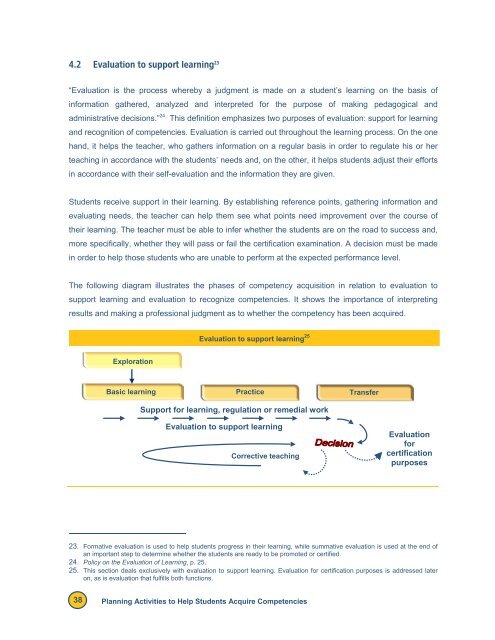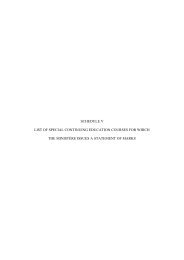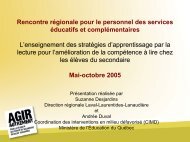Reference Framework for Planning Learning and Evaluation Activities
Reference Framework for Planning Learning and Evaluation Activities
Reference Framework for Planning Learning and Evaluation Activities
You also want an ePaper? Increase the reach of your titles
YUMPU automatically turns print PDFs into web optimized ePapers that Google loves.
4.2 <strong>Evaluation</strong> to support learning 23<br />
“<strong>Evaluation</strong> is the process whereby a judgment is made on a student’s learning on the basis of<br />
in<strong>for</strong>mation gathered, analyzed <strong>and</strong> interpreted <strong>for</strong> the purpose of making pedagogical <strong>and</strong><br />
administrative decisions.” 24 This definition emphasizes two purposes of evaluation: support <strong>for</strong> learning<br />
<strong>and</strong> recognition of competencies. <strong>Evaluation</strong> is carried out throughout the learning process. On the one<br />
h<strong>and</strong>, it helps the teacher, who gathers in<strong>for</strong>mation on a regular basis in order to regulate his or her<br />
teaching in accordance with the students’ needs <strong>and</strong>, on the other, it helps students adjust their ef<strong>for</strong>ts<br />
in accordance with their self-evaluation <strong>and</strong> the in<strong>for</strong>mation they are given.<br />
Students receive support in their learning. By establishing reference points, gathering in<strong>for</strong>mation <strong>and</strong><br />
evaluating needs, the teacher can help them see what points need improvement over the course of<br />
their learning. The teacher must be able to infer whether the students are on the road to success <strong>and</strong>,<br />
more specifically, whether they will pass or fail the certification examination. A decision must be made<br />
in order to help those students who are unable to per<strong>for</strong>m at the expected per<strong>for</strong>mance level.<br />
The following diagram illustrates the phases of competency acquisition in relation to evaluation to<br />
support learning <strong>and</strong> evaluation to recognize competencies. It shows the importance of interpreting<br />
results <strong>and</strong> making a professional judgment as to whether the competency has been acquired.<br />
<strong>Evaluation</strong> to support learning 25<br />
Exploration<br />
Basic learning<br />
Practice<br />
Transfer<br />
Support <strong>for</strong> learning, regulation or remedial work<br />
<strong>Evaluation</strong> to support learning<br />
Corrective teaching<br />
<strong>Evaluation</strong><br />
<strong>for</strong><br />
certification<br />
purposes<br />
23. Formative evaluation is used to help students progress in their learning, while summative evaluation is used at the end of<br />
an important step to determine whether the students are ready to be promoted or certified.<br />
24. Policy on the <strong>Evaluation</strong> of <strong>Learning</strong>, p. 25.<br />
25. This section deals exclusively with evaluation to support learning. <strong>Evaluation</strong> <strong>for</strong> certification purposes is addressed later<br />
on, as is evaluation that fulfills both functions.<br />
38 <strong>Planning</strong> <strong>Activities</strong> to Help Students Acquire Competencies




